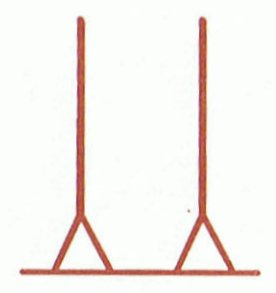|
|||||||||||||

GD81
|
pare |
This rare glyph type apparently should, according to the words of Metoro, represent the sky. The word pare seems basically to have meant a covering (shield, veil, etc). |
|||||||||||
A few preliminary remarks and imaginations: 1. In the toki chapter, I have suggested there are systematic and meaningful contrasts between Egyptian images and rongorongo signs, for instance between the hieroglyph for cloth (menchet) and the glyph type which I have labelled henua ora ('living earth'):
Evidence from the texts indicates that a better name than henua ora could have been 'black cloth', and indeed I have often avoided the name henua ora. Instead I found 'recycling station' to be more descriptive of the idea perceived in the texts. However, in the Swedish language henua ora would literally be translated into livmoder, which word means uterus, womb. The womb is the source of life. In French womb is matrice. In Spanish it is matriz or útero. The recycling of the spirit apparently implies that every baby is 'impregnated' by a spirit which has descended (like a fly) from the sky. The henua ora glyph type has in its center a single 'inverted pillar' of a kind like the 2 in menchet. And instead of a straight horizontal line for the ground there is a parabolic form, which means we can imagine it as a kind of 'cup' containing an 'embryo' (hidden in the dark) at the bottom.
The female 'cup' form in henua ora has as its opposite, I think, in the male 'cap' form of pare. Instead of a single 'mata' at the bottom there are twin mata high up. The sphere of the sky has two halves, 'cup' (below) and 'cap' (above): ... In the beginning there was nothing but the sea, and above soared the Old-Spider. One day the Old-Spider found a giant clam, took it up, and tried to find if this object had any opening, but could find none. She tapped on it, and as it sounded hollow, she decided it was empty. By repeating a charm, she opened the two shells and slipped inside. She could see nothing, because the sun and the moon did not then exist; and then, she could not stand up because there was not enough room in the shellfish ... |
|||||||||||||

